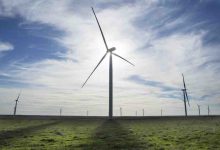It’s been a stunning ray of sunshine in a bleak period for Australia’s renewables industry. In a year that has seen investment slump by more than half in a sector plagued by connection issues and commissioning delays, and policy indifference, the Queensland government and Spain’s Acciona have announced they will build what will be Australia’s biggest wind farm to date.
And it will likely have set a new benchmark for pricing, at least with government tenders.
The 1029MW MacIntyre wind project, located some 55kms south west of Warwick in Queensland’s Southern Downs region, will be nearly twice as big as the next largest wind farm built or under construction in Australia, the 530MW Stockyard Hill facility in Victoria.
And MacIntyre will also beat Stockyard Hill (said to be in the low $50s/MWh) and all others on price – at least, that is the assumption of the market, and particular of the rival bidders who missed out on the long-awaited Queensland government tender.
It was more than two years ago when the state government announced it would seek to underwrite more renewables and storage capacity in Queensland by seeking a tender for 400MW of new capacity. It attracted a huge number of proposals, but nothing came of it until the middle of last year, when state energy minister produced a “short-list” of 10 projects that were invited to submit updated proposals, particularly on price.
In that re-launch, state energy minister Anthony Lynham mocked the (ongoing) push by conservatives for a new coal fired generator near Townsville, boasting that he could ‘”get a wind farm for around $44″ (a megawatt hour) and a solar farm for around $50/MWh, compared to the cost of new coal of well above $130/MWh.
That number of $44/MWh is a pretty good guide for where Acciona must have bid into the RE400 tender for a solid part of its 1,029MW MacIntyre wind project, which will begin construction next year after landing the entirety of the auction capacity managed by Queensland’s newly created clean energy generator, CleanCo.

If that’s the case, it means that MacIntyre is not just the biggest wind project to get the go-ahead in Australia, it will also be the lowest priced wind contract in Australia, at least in terms of contracts (usually known as power purchase agreements) in the public arena.
It would also likely beat the 212MW Yandin wind farm being built in Western Australia by Alinta, which boasts a phenomenal capacity factor of around 50 per cent. Alinta CEO Jeff Dimery told RenewEconomy’s Energy Insiders podcast that the levellised costs of energy from that facility was in the “high $40s/MWh”, which made it likely the lowest cost wind farm in Australia, beating the “low $50s/MWh” quoted for Stockyard Hill in Victoria.
Of course, there is a degree of guesswork in this. Apart from the tender conducted by the ACT government as part of its successful efforts to source the equivalent of 100 per cent of its electricity needs from renewables, contract prices are never revealed.
Snowy Hydro’s CEO Paul Broad has boasted of being able to secure wind and solar output in the $40s/MWh, but that federal government owned utility has not released the details of the contracts it has signed. And some wind farms might offer a cheap price for a firm and lengthy contract, and then try to make more money out of the wholesale market.
But those options for making more money on the “merchant” or spot price component are more limited for MacIntyre.
Some 400MW of the facility is contracted to CleanCo, which – rather bizarrely – will build its own 100MW component within the MacIntyre complex that it will own and operate.
That leaves more than 500MW yet to be contracted, and given that the state’s wholesale prices are being put at around $50/MWh on the futures market, there’s little opportunity to get a premium elsewhere.
Still, it’s likely that MacIntyre’s wind output will be able to dodge some or even most of the middle of the day lows caused by the huge amount of rooftop solar and large scale solar, which is one reason that no solar projects got a look in (only one was short-listed).
MacIntyre’s low pricing and ability to beat out competitors, including Goldwind’s 800MW Clarke River wind facility near Rockhampton, that included storage, is likely a function of its scale. And, the fact that such prices can be achieved – even given the uncertainty caused by grid congestion, connection issues, contracting problems, and uncertainty over rules, policies and election outcomes – is promising for the industry.
RenewEconomy sought further comment from both CleanCo and the state government about the pricing, and the decision to award the tender in its entirety to a single party. (Other government such as Victoria and the ACT have chosen a basket of winners, and leveraged more capacity that way. But maybe Queensland thought that the extra 500MW from MacIntyre was leverage enough).
No further information was given. Acciona would only say that it was priced at a point where it could get built.
Tender rivals, who chose not to go on the record – probably because it is hoped that CleanCo might negotiate further contracts with other parties, under its mandate for a further 1000MW of contracted capacity by 2025 – hoped that was the case. They all assumed the price was well below $50/MWh, they just wanted to know by how much. “I hope they can deliver,” said one.
RenewEconomy and its sister sites One Step Off The Grid and The Driven will continue to publish throughout the Covid-19 crisis, posting good news about technology and project development, and holding government, regulators and business to account. But as the conference market evaporates, and some advertisers pull in their budgets, readers can help by making a voluntary donation here to help ensure we can continue to offer the service free of charge and to as wide an audience as possible. Thankyou for your support.










